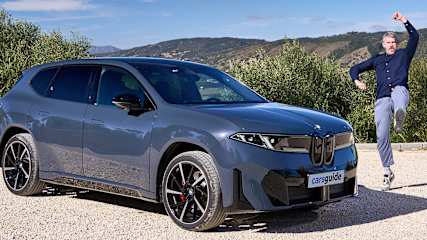2012 BMW 5 Series Reviews
You'll find all our 2012 BMW 5 Series reviews right here.
Our reviews offer detailed analysis of the 5 Series's features, design, practicality, fuel consumption, engine and transmission, safety, ownership and what it's like to drive.
The most recent reviews sit up the top of the page, but if you're looking for an older model year or shopping for a used car, scroll down to find BMW 5 Series dating back as far as 1973.
BMW Reviews and News
.jpg)
Australia's 100 best selling cars for 2025
Read the article
By Tim Gibson · 09 Jan 2026
The Australian new car market is going through one of its biggest changes to date.A wave of budget-focused Chinese brands has washed over the market in the past two years, eating away into the sales of many established carmakers.The emergence of new technologies such as hybrid, plug-in hybrid and battery electric vehicles will change the cars we drive forever.Despite that, some things have stayed the same. Diesel-powered utes and 4WDs are the dominant force in Aussie motoring, but new models are snapping at their heels.Here are the best selling 100 vehicles in Australia during the past year.
.jpg)
Safety ratings due to expire on these cars
Read the article
By Tim Gibson · 29 Dec 2025
Some of Australia's favourite models will see their safety ratings lapse in 2026.

Huge EV tax break could get axed
Read the article
By Tim Gibson · 16 Dec 2025
The federal government has announced there will be a statutory review into the Electric Car Discount.

Europe to ditch petrol, diesel ban: report
Read the article
By Tim Gibson · 15 Dec 2025
A landmark car ban in Europe could be overturned, according to reports.

Could a BMW drive you home from the pub?
Read the article
By Tim Nicholson · 09 Dec 2025
BMW is working on a rival to Tesla’s Full Self Driving mode, but the company is in no rush to roll it out before it’s ready.

BMW iX3 2026 review: International first drive
Read the article
By Tim Nicholson · 04 Dec 2025
BMW’s 'Neue Klasse' program includes a complete overhaul of its line-up, led by tech-laden EVs like the new iX3 and coming electric 3 Series, the i3.Every model from here on will incorporate elements of Neue Klasse like design or cabin tech, but the iX3 gets the full overhaul. It is an all-new car. Not many carmakers can legitimately claim that these days.To ram home how critical this new model philosophy is to BMW, the company has spent a total of €10 billion (A$17b) on Neue Klasse. No pressure on the iX3 then…We spent some quality time with the new electric mid-size SUV in southern Spain at the international first drive to see if the investment has paid off. Spoiler alert: it has.Underpinning the iX3 is new architecture designed for electric powertrains and a sophisticated software set-up with four ‘superbrains’, or computers, handling driving dynamics, automated driving and advanced driver assist, multimedia and in-car tech.For now BMW has only revealed details of one grade, the highly specified iX3 50 xDrive. This is a dual-motor set-up (one motor on each axle) ensuring all-wheel-drive traction and the specs on paper are impressive.Total outputs are 345kW of power and 645Nm of torque, allowing for a quick 0-100km/h time of 4.9sec. It has a 108kWh lithium-ion battery pack, housed under the floor with cylindrical cells.The maximum charging rate is 400kW, which, using an 800-volt DC charging station, would theoretically allow you to add 350km of charge in just 10 minutes, or to recharge from 10 to 80 per cent in 20 minutes. It’s also capable of vehicle-to-load functionality for bi-directional charging.BMW won’t release pricing until the new year, but given this is a sub-M flagship grade, it won’t be cheap. Considering its European pricing and how much rivals like the Porsche Macan 4 ($137,600) and Audi Q6 e-tron quattro ($122,500) cost in Australia, the 50 xDrive could slot somewhere between $120,000 and $130,000.More grades will be revealed and confirmed, likely including more affordable single-motor grades, while a high-powered M version of iX3 is also expected.But for now it’s all about the 50 xDrive. In the metal it’s a beautifully designed SUV. There’s a clear connection to the Neue Klasse X concept that came before it. The iX3 has few lines, with BMW designers instead opting for a cleaner approach.Gone are circular headlights, replaced instead by quad vertical LED lights and (rather unsustainable) chrome is replaced by illumination for the toothy kidney grille. If you’re not a fan of BMW’s large vertical grilles, this version is much more subtle and works beautifully with the front-end styling.The signature of the long, wide tail-lights looks brilliant and will stand out in the segment. The tailgate spoiler adds a sporty touch and the glasshouse is large without looking awkward.It also bears no resemblance to the current internal combustion X3, which only went on sale in Australia early this year. That model was well into development when Neue Klasse was floated but expect it to gain design cues from iX3 when it gets its first major makeover in a couple of years.Inside, the iX3 is like no BMW before it. Sustainable materials are found throughout, including leather, and there’s an absence of buttons with most functions housed in the central screen.A key feature is the 'Panoramic iDrive' which includes a new version of an instrument cluster. Instead of a small screen immediately behind the steering wheel, the iX3 has a projection at the bottom of the windscreen stretching from A-pillar to A-pillar.In practice, it’s hard to fault. The display is the right size and all the information you need is in your eye line. If the additional widgets on the passenger side are distracting you can simply remove them. I found no such distractions. This is a game-changing system and feels safer than having the speed and other key information in a central screen like many other EVs.There’s loads of functionality in the central multimedia screen but once you spend some time getting to know it, it’s intuitive, fast and visually appealing.BMW’s polarising four-spoke steering wheel (the fourth spoke is at 12 o'clock) is not to my taste visually (the M Sport two-spoke is nicer), but the functionality is cool. BMW’s ‘shy tech’ philosophy means certain functions on the wheel are only visible when they are available to use, like driver assist functions.BMW has worked hard to improve its 'Intelligent Personal Assistant' voice command, but it was glitchy in the late production cars we drove. At one point I asked it to open the rear passenger window and it opened the front one instead. It’s also super sensitive. It activated every time I said ‘BMW’, which was a lot.We used the sat-nav on our extensive drive and it's the most capable in-house system I’ve experienced.Aside from the tech, the front seats are superb in regular spec and M Sport guise. Not as tight as some M Sport seats, and plush, with beautiful materials. The rear seats are flatter but there's plenty of leg and head room, as well as amenities like USB-C ports, air vents and climate controls.The boot is long and can take 520 litres of cargo with all seats in place. There’s a 58L front trunk, too.So far the iX3 impresses. But the on-road experience takes this car to another level.Of course it’s quick, it’s an EV so that’s not hard. It’s the way it does everything else that elevates it.The steering is phenomenal and a genuine highlight of the drive experience. There’s feeling behind it and the size and shape of the wheel adds to the engagement. It’s sharp (2.8 turns lock to lock), yet silky smooth.That’s a word I used a lot driving this car - ‘smooth’. The iX3 does virtually everything smoothly. It’s effortless, but still a driver’s car.The way this 2.3-tonne EV carves up corners is something to behold. It takes corners so confidently you’ll forget you’re driving a family SUV. BMW has engineered this car for fun. It bodes well for the coming i3 sedan.It’s never floaty or bouncy. But it’s also not so pinned to the road that it’s unpleasant or firm. It’s flat, chuckable and nimble, but also a comfortable cruiser on the open road.The ride quality is excellent even on 21-inch alloy wheels. In saying that, these were typically perfect European roads, so let's see how it goes on Australia's notoriously terrible surfaces.The advanced driver assistance tech is also impressive and doesn’t intrude. BMW engineers worked hard to ensure the ADAS works with the driver, not against it. The 'Highway Assist' semi-self driving on the freeway worked without fault, changing lanes autonomously when safe to do so.The iX3 even has a pleasant EV sound. There’s almost a hint of a six-cylinder petrol engine to the synthetic sound.BMW says it is capable of energy efficiency of around 15.1kWh/100km. We saw figures around 18kWh. There was 715km of range (or 75 per cent capacity) left after 145km of driving.

Best SUVs Australia 2026
Read the article
By Laura Berry · 02 Dec 2025
The age of SUVs is firmly upon us, and carmakers are rolling out high-riding wagons at an astonishing rate.
.jpg)
This tech could be a game changer in Oz
Read the article
By Tim Gibson · 01 Dec 2025
BMW looks to introduce a new type of hybrid.
.jpg)
Best Family Cars Australia 2026
Read the article
By Dom Tripolone · 30 Nov 2025
2026 might be one of the best years for Australian families on the hunt for a new ride.
.jpg)
What you must know before buying a used car
Read the article
By Tim Gibson · 20 Nov 2025
A new safety report has rated some popular used cars.Monash University’s Accident Research Centre Used Car Safety Ratings for 2025 have been revealed, with 23 new vehicles added to the handbook that covers vehicles built between 1982 and 2023.Top picks of the newly added vehicles were the 2013-22 Ford Transit van, 2014-21 BMW 2 Series, 2019-23 Mazda CX-30, 2017-23 Mitsubishi Eclipse Cross and 2018-23 Subaru Forester.The report revealed the average risk of being killed or seriously injured across all road users involved in a crash is 34 per cent lower in a vehicle manufactured from 2022 onwards, compared to 20 years ago. The ratings report looked at crash data analysing more than 9.5 million vehicles and 2.6 million road users in Australia and New Zealand between 1987 and 2022. It rated 561 vehicle models that were built between 1982 and 2023 looking at factors such as crash location, driver age and the number of vehicles involved. It measured safety through an overall rating with three categories: driver safety, other road user safety and crash avoidance. All are ranked out of five.Certain vehicles received a ‘Safer Pick’, where they scored five stars for overall and driver protection, with at least four stars for other road user safety and crash avoidance. Almost all 'Safer Pick' vehicles are available second-hand for under $25,000 and more than half priced below $10,000, according to Monash University.The report made particular note of the high risk attached to ute crashes, with only one ute achieving a five-star overall rating, and 70 per cent one or two stars.Some of this real-world data does not line up with ANCAP safety ratings. The Ford Mustang, manufactured from 2015-2022, received a two-star rating, which was later upgraded to three-stars with ANCAP. Yet, it achieved a near all-excellent rating in real-world crashes, according to the data.The full data set is available here.





